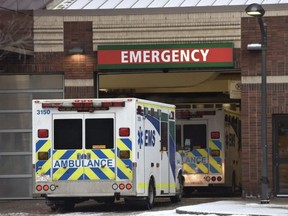Emergency waiting room populations have ballooned across the province, and hospitals are way past capacity in Edmonton, according to the head of the Alberta Medical Association.
Health
‘As bad as we’ve seen it in 25 years’: AMA president sounds alarm as Alberta hospital wait times rise

“We’ve never had that many in the Edmonton zone,” Parks said.
After mitigation, that number shrunk to 166 without beds, but that’s still alarming, he said.
Overcapacity protocols have kicked in.
“We need to balance the loads from across the province right now so we can gain capacity,” he said.
“They may need to travel geographically away from their families,” he said.
In a couple of instances, there were beds listed as empty and available, but they couldn’t staff them, Parks said.
“If we don’t have the work force and the human beings to staff it, they’re really no good to us,” he said. “It’s really important to understand the reasons they can’t go up on the floors. In some hospitals they’re at 130 to 150 per cent capacity. That means if they’re staffed for 100 patients, they have 150 patients. They just can’t take any more.”
Canadians face historic wait times: Fraser Institute
This news comes in the wake of a new Fraser Institute study that shows Canadians now face the longest health-care wait times in the nation’s history, roughly 28 weeks.
The non-partisan Canadian public policy think-tank released results last Thursday from an annual study that examines the total wait time faced by patients. According to the study, the median wait time for patients in Canada has climbed to 27.7 weeks, the longest ever recorded. Alberta’s wait times are 33.5 weeks.
Among the provinces, only three provinces had longer wait times than Alberta — New Brunswick (52.6), P.E.I (55.2) and Nova Scotia (56.7).
“COVID-19 and related hospital closures have exacerbated but are not the cause of Canada’s historic wait times challenges,” said Bacchus Barua, director of the Fraser Institute’s Centre for Health Policy Studies. “Previous results revealed that patients waited an estimated 20.9 weeks for medically necessary elective care in 2019 — long before the pandemic started.”
“Excessively long wait times remain a defining characteristic of Canada’s health-care system,” said Mackenzie Moir, Fraser Institute policy analyst and co-author of the report. “And they aren’t simply minor inconveniences, they can result in increased suffering for patients, lost productivity at work, a decreased quality of life, and in the worst cases, disability or death.”
rostad@postmedia.com
jcarmichael@postmedia.com

Health
How many Nova Scotians are on the doctor wait-list? Number hit 160,000 in June

HALIFAX – The Nova Scotia government says it could be months before it reveals how many people are on the wait-list for a family doctor.
The head of the province’s health authority told reporters Wednesday that the government won’t release updated data until the 160,000 people who were on the wait-list in June are contacted to verify whether they still need primary care.
Karen Oldfield said Nova Scotia Health is working on validating the primary care wait-list data before posting new numbers, and that work may take a matter of months. The most recent public wait-list figures are from June 1, when 160,234 people, or about 16 per cent of the population, were on it.
“It’s going to take time to make 160,000 calls,” Oldfield said. “We are not talking weeks, we are talking months.”
The interim CEO and president of Nova Scotia Health said people on the list are being asked where they live, whether they still need a family doctor, and to give an update on their health.
A spokesperson with the province’s Health Department says the government and its health authority are “working hard” to turn the wait-list registry into a useful tool, adding that the data will be shared once it is validated.
Nova Scotia’s NDP are calling on Premier Tim Houston to immediately release statistics on how many people are looking for a family doctor. On Tuesday, the NDP introduced a bill that would require the health minister to make the number public every month.
“It is unacceptable for the list to be more than three months out of date,” NDP Leader Claudia Chender said Tuesday.
Chender said releasing this data regularly is vital so Nova Scotians can track the government’s progress on its main 2021 campaign promise: fixing health care.
The number of people in need of a family doctor has more than doubled between the 2021 summer election campaign and June 2024. Since September 2021 about 300 doctors have been added to the provincial health system, the Health Department said.
“We’ll know if Tim Houston is keeping his 2021 election promise to fix health care when Nova Scotians are attached to primary care,” Chender said.
This report by The Canadian Press was first published Sept. 11, 2024.
The Canadian Press. All rights reserved.
Health
Newfoundland and Labrador monitoring rise in whooping cough cases: medical officer

ST. JOHN’S, N.L. – Newfoundland and Labrador‘s chief medical officer is monitoring the rise of whooping cough infections across the province as cases of the highly contagious disease continue to grow across Canada.
Dr. Janice Fitzgerald says that so far this year, the province has recorded 230 confirmed cases of the vaccine-preventable respiratory tract infection, also known as pertussis.
Late last month, Quebec reported more than 11,000 cases during the same time period, while Ontario counted 470 cases, well above the five-year average of 98. In Quebec, the majority of patients are between the ages of 10 and 14.
Meanwhile, New Brunswick has declared a whooping cough outbreak across the province. A total of 141 cases were reported by last month, exceeding the five-year average of 34.
The disease can lead to severe complications among vulnerable populations including infants, who are at the highest risk of suffering from complications like pneumonia and seizures. Symptoms may start with a runny nose, mild fever and cough, then progress to severe coughing accompanied by a distinctive “whooping” sound during inhalation.
“The public, especially pregnant people and those in close contact with infants, are encouraged to be aware of symptoms related to pertussis and to ensure vaccinations are up to date,” Newfoundland and Labrador’s Health Department said in a statement.
Whooping cough can be treated with antibiotics, but vaccination is the most effective way to control the spread of the disease. As a result, the province has expanded immunization efforts this school year. While booster doses are already offered in Grade 9, the vaccine is now being offered to Grade 8 students as well.
Public health officials say whooping cough is a cyclical disease that increases every two to five or six years.
Meanwhile, New Brunswick’s acting chief medical officer of health expects the current case count to get worse before tapering off.
A rise in whooping cough cases has also been reported in the United States and elsewhere. The Pan American Health Organization issued an alert in July encouraging countries to ramp up their surveillance and vaccination coverage.
This report by The Canadian Press was first published Sept. 10, 2024.
The Canadian Press. All rights reserved.
Health
Bizarre Sunlight Loophole Melts Belly Fat Fast!
Product Name: Bizarre Sunlight Loophole Melts Belly Fat Fast!
All orders are protected by SSL encryption – the highest industry standard for online security from trusted vendors.

Bizarre Sunlight Loophole Melts Belly Fat Fast! is backed with a 60 Day No Questions Asked Money Back Guarantee. If within the first 60 days of receipt you are not satisfied with Wake Up Lean™, you can request a refund by sending an email to the address given inside the product and we will immediately refund your entire purchase price, with no questions asked.
-

 News19 hours ago
News19 hours agoSingh claps back at Poilievre ahead of House return
-

 News18 hours ago
News18 hours agoMore than 67 million people watched Donald Trump and Kamala Harris debate. That’s way up from June
-

 News18 hours ago
News18 hours agoTaxi driver suspected in fatal B.C. hit-and-run has left Canada: RCMP
-

 News18 hours ago
News18 hours agoThe ancient jar smashed by a 4-year-old is back on display at an Israeli museum after repair
-

 News19 hours ago
News19 hours agoMounties say there’s no evidence Lytton, B.C., wildfire was arson; cause unknown
-
News6 hours ago
Local Toronto business story – Events Industry : new national brand, Element Event Solutions
-

 News7 hours ago
News7 hours agoReggie Bush was at his LA-area home when 3 male suspects attempted to break in
-

 News18 hours ago
News18 hours agoAlberta Premier Smith says she wants Calgary Green Line to proceed as first pitched



















